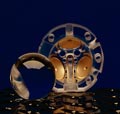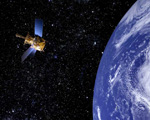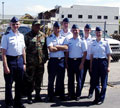
STATUS UPDATE AS OF 20 NOVEMBER 2006:
GP-B DATA ANALYSIS & RESULTS ANNOUNCEMENT STATUS
During the 50-week science phase of the GP-B mission and the 7-week instrument calibration phase, which lasted from August 2004-September 2005, we collected over a terabyte of experimental data. Analysis has been progressing through a 3-phase plan, each subsequent phase building on those preceding it.
In Phase I, which lasted from the end of September 2005 through February 2006, the analysis focused on a short-term, day-by-day or even orbit-by-orbit, examination of the data. The overall goals of this phase were to optimize the data analysis routines, calibrate out instrumentation effects, and produce initial "gyro spin axis orientation of the day" estimates for each gyro individually. At this stage, the focus was on individual gyro performance; there was no attempt to combine or compare the results of all four gyros, nor was there even an attempt to estimate the gyro drift rates.
Phase II, which lasted from March-August, 2006, focused on understanding and compensating for certain long-term systematic effects in the data that spanned weeks or months. The results of the Phase II analysis enabled the team to improve the accuracy of the analysis, yielding increased precision for gyro precession rates over short intervals. Phase II culminated with the 15th meeting of our GP-B Science Advisory Committee (SAC) here at Stanford on 8-9 September 2006. During this important meeting, our data analysis team presented a complete progress report to the SAC.
As of November 20, we are well into Phase III of the data analysis, which we expect to be concluded by late February, 2007. Whereas in Phases I and II, the focus was on individual gyro performance, during Phase III, the data from all four gyros is being integrated over the entire experiment. The results of this phase will be both individual and correlated changes in gyro spin axis orientation covering the entire 50-week experimental period for all four gyros. During this final analysis phase, we are continuing to pursue both geometric and algebraic interpretations of the data, which is enabling us to improve the accuracy of the results.
The Phase III results will be relative to the position of our guide star, IM Pegasi, which changed continually throughout the experiment. Thus, the final step in the analysis, currently scheduled to occur early in the spring of 2007, will be to combine our gyro spin axis orientation results with data mapping the proper motion of IM Pegasi relative to the unchanging position of a distant quasar. The proper motion of IM Pegasi has been mapped with unprecedented precision using a technique called Very Long Baseline Interferometry (VLBI) by Irwin Shapiro and his team at the Harvard-Smithsonian Center for Astrophysics (CfA), in collaboration with Norbert Bartel at York University in Toronto and French astronomer Jean-Francois Lestrade.
At the conclusion of phase III, playing the role of our own harshest critic, our science team will perform a careful and thorough final review of the analysis and results, checking and cross-checking each aspect to ensure the soundness of our procedures and the validity of our outcomes. We will then turn the analysis and results over to the SAC, which has been closely monitoring our experimental methods, data analysis procedures, and progress for the past eight years, to obtain its independent review. Moreover, we will seek independent reviews from a number of international experts.
In addition to analyzing the data, members of our team are now in the process of preparing scientific and engineering papers for publication in late 2006-2007. We have also begun discussions with NASA to plan a formal public announcement of the results of this unprecedented test of General Relativity. We expect to make this announcement of the results in April 2007.
GRAVITY PROBE SPACECRAFT & PAYLOAD STATUS AT A GLANCE

| Item | Current Status |
| Mission Elapsed Time | 943 days (134.7 weeks/30.9 months) |
IOC Phase |
129 days (4.2 months) |
Science Phase |
352 days (11.6 months) |
Final Calibration Phase |
43 days (1.3 months) |
Extended Science Phase |
4 days |
Post Mission Phase |
415 days (59.3 weeks/13.6 months) |
| Current Orbit # | 13,911 as of 12:00 PM PDT |
| Spacecraft General Health | Good |
| Roll Rate | 0.1 rpm (10 minutes per revolution) |
| Gyro Suspension System (GSS) | Gyro #1 is in analog backup suspension mode; gyros #2, #3, and #4 are digitally suspended |
| Gyro Spin Rates | N/A; gyro rotors "tumbling" slowly rather than spinning |
| Dewar Inside Temperature | ~256 kelvin (-17 C) and falling slightly |
| Dewar Outer Shell Temperature | ~264 kelvin (-9 C) and falling |
| Global Positioning System (GPS) lock | Nominal |
| Attitude Control System (ATC) | Nominal for post-mission operation |
| Telescope Readout (TRE) | Pointing performance too low to lock onto guide star |
| Command & Data Handling (CDH) | B-side (backup) computer in control Multi-bit errors (MBE): 1 in CCCA Backup computer 3 in GSS computers 0 in SRE computer (turned off) |
MISSION DIRECTOR'S SUMMARY
On Mission Day 943, both the GP-B space vehicle and payload remain in good health. All active subsystems, including solar arrays/electrical power, Experiment Control Unit (ECU), flight computer, star trackers, magnetic sensing system (MSS) and magnetic torque rods, gyro suspension system (GSS), and telescope detectors, are performing nominally. The spacecraft is now essentially in a hibernation state.
Throughout October and early November, our small mission operations team continued performing tests to ensure that the software and configuration updates that were uploaded to the spacecraft in September for hibernating the spacecraft were functioning properly. During these tests, the team rebooted the on-board computer, which in turn reset the spacecraft roll rate to 0.1 rpm (10 minutes per revolution).
Tests of the most important hibernation change—the reconfiguration of the spacecraft's communications equipment to prevent it from automatically turning itself on and transmitting data in response to a safe mode condition or on-board computer reboot—suggested further fine tuning of a few key software routines. These modifications are in process and should be completed shortly. Once these final modifications have been uploaded and tested, the hibernation work will be finished.
The United States Air Force Academy (USAFA) is continuing its preparations to begin using the spacecraft part time—shared with our use here at Stanford—as a space operations training vehicle. Last month, a member of the USAFA spacecraft operations team came to Stanford, loaded a ground station communications POD (a set of computer consoles) into a van, and drove it back to the academy in Colorado Springs, where it is being set up. Another communications POD is also being readied for shipment to the USAFA, and our Mission Operations Center (MOC) Computer Systems Manager will be traveling to Colorado Springs shortly to help the USAFA team get these communications PODs configured and running. It is now anticipated that the USAFA will begin controlling the spacecraft sometime early next year.
GP-B MISSION NEWS—POLHODE MOTION IN THE GP-B GYROSCOPES
This month's mission news story is a bit long for our Home page, so we have placed it on its own Web page.
CLICK HERE TO READ THE STORY.
FINAL SCHEDULED 2006 GP-B STATUS UPDATE & MISSION NEWS IN LATE DECEMBER
Our final regularly scheduled update for this year be towards the end of December. Of course, we will send out a timely update if there are any important changes in the spacecraft's status, or if noteworthy events occur here at GP-B in the meantime.
DOWNLOAD PDF COPIES OF "GP-B IN A NUTSHELL" & "NASA/GP-B FACT SHEET"
For a two-page, up-to-date overview of GP-B in Adobe Acrobat PDF format, click here to view/download "Gravity Probe B in a Nutshell." In addition, you'll now find our 6-page NASA/GP-B Fact Sheet (PDF format) listed as the last navigation link under "What is GP-B" in the upper left corner of this Web page. You can also click here to download a copy.
VIEW OR DOWNLOAD VIDEO/AUDIO/PRESENTATION SLIDES OF MAY 18, 2006 EVERITT PUBLIC LECTURE ON GP-B

 On Thursday evening, May 18, 2006, GP-B Principal Investigator, Francis Everitt, gave a 90-minute free public lecture entitled: “Testing Einstein in Space: The Gravity Probe B Mission.” The lecture was sponsored by the Stanford Continuing Studies program, as part its Brainstorms: New Frontiers in Science & Engineering lecture series.
On Thursday evening, May 18, 2006, GP-B Principal Investigator, Francis Everitt, gave a 90-minute free public lecture entitled: “Testing Einstein in Space: The Gravity Probe B Mission.” The lecture was sponsored by the Stanford Continuing Studies program, as part its Brainstorms: New Frontiers in Science & Engineering lecture series.
 Click here to view
an MPEG4 streaming video of Professor Everitt's May 18th lecture.
Click here to view
an MPEG4 streaming video of Professor Everitt's May 18th lecture.
Both audio only and video versions of this lecture are also available on the Stanford on iTUNES U Web site. This Web page automatically launches the Apple iTunes program on both Macintosh and Windows computers, with a special Stanford on iTunes U "music store," containing free downloads of Stanford lectures, performances, and events. Francis Everitt's "Testing Einstein in Space" lecture is located in the Faculty Lectures section. People with audio-only iPods can download the version under the Audio tab; people with 5th generation (video) iPodfs can download the version under the Video tab.
Photos, Drawings, and Video: The composite photo of the GP-B spacecraft orbiting above the Earth, the photos of our new Mission Operations Center, and Francis Everitt's lecture were created/taken by GP-B Public Affairs Coordinator, Bob Kahn. Bob also created the animated wooden blocks that accompany the polhode story. The historical portraits of Euler, Poinsot, and Newcomb in the polhode story are from various Web sources, and the two video clips in that story are courtesy of NASA.The group photo of the team from the U.S. Air Force Academy was taken by former GP-B Program Manager, Gaylord Green. All other photos and graphics, both on this page and in the polhode story, are part of the GP-B Image Archive here at Stanford. The MPEG-4 video of Francis Everitt's lecture was created by Stanford Video. Click on the thumbnails of any photo or graphic to view these images at full size.
MORE LINKS ON RECENT TOPICS
- Track the satellite in the sky
- Photo, video & and news links
- Build a paper model of the GP-B Spacecraft
- Following the mission online
- Our mailing list—receive the weekly highlights via email
- The GP-B Launch Companion in Adobe Acrobat PDF format. Please note: this file is 1.6 MB, so it may take awhile to download if you have a slow Internet connection.
Previous Update
Index of Updates




